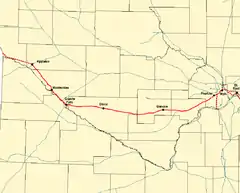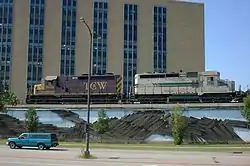Twin Cities and Western Railroad
The Twin Cities and Western Railroad (reporting mark TCWR) is a railroad operating in the U.S. state of Minnesota which started operations on July 27, 1991.[1] Trackage includes the former Soo Line Railroad "Ortonville Line", originally built as the first part of the Pacific extension of the Milwaukee Road. This main line extends from Hopkins, Minnesota (a Western suburb of the Twin Cities) to Appleton, Minnesota. The line was originally built between Hopkins and Cologne Minnesota in 1876 by Hastings and Dakota Railroad. In 1913, the Milwaukee Road rerouted it, reducing the curves. The line was eventually extended to the Pacific.
 Twin Cities and Western Railroad trackage. Solid lines are track owned by TCWR; dotted lines are TCWR trackage rights. | |
 A Twin Cities and Western Railroad train waits in downtown Saint Paul, Minnesota. | |
| Overview | |
|---|---|
| Headquarters | Glencoe, Minnesota |
| Reporting mark | TCWR |
| Locale | Minnesota, South Dakota |
| Dates of operation | 1991–present |
| Technical | |
| Track gauge | 4 ft 8 1⁄2 in (1,435 mm) |
| Length | 229 miles (369 km) |
| Other | |
| Website | Official website |
As of 1991, the TCWR also has trackage rights over the BNSF Railway and the Canadian Pacific Railway. In 2012, the TCWR purchased the Sisseton Milbank Railroad and it now operates as a subsidiary of the Twin Cities and Western Railway.[2]
The company is also affiliated with the Red River Valley and Western Railroad in North Dakota, and the Minnesota Prairie Line, which has a junction with the Twin Cities and Western in Norwood Young America, Minnesota.
Current routing
Until Hiawatha Avenue (Minnesota State Highway 55) was reconstructed in the 1990s and plans for the Hiawatha Line light rail service entered late stages, the Twin Cities and Western operated on Canadian Pacific's Bass Lake Subdivision through the 29th Street railway trench in Minneapolis, now known as the Midtown Greenway. The tracks continued along the former Milwaukee Road Short Line into Saint Paul, where TC&W would access rail yards operated by Canadian Pacific, the Minnesota Commercial Railway, and others. As part of the Hiawatha project, the railroad's route to St Paul was moved from the 29th Street Corridor to the Kenilworth Corridor (former M&STL/C&NW track) to Cedar Lake Junction onto the BNSF just west of downtown Minneapolis. The re-route occurred August 1998.
After the re-route onto to Kenilworth Corridor occurred in 1998, HCRRA constructed the Kenilworth Trail adjacent to the railroad track, using railroad right-of-way acquired from the Chicago North Western Railway by the Hennepin County Regional Railroad Authority.[3] The Kenilworth alignment had first been built as part of the Minneapolis and St. Louis Railway and eventually became part of the Chicago and North Western Railway.[4] The Hennepin County Regional Rail Authority acquired the land (1984?) prior to when C&NW abandoned the line (1993?) .[3] The existing freight operation shares the corridor with the Kenilworth Trail.
The temporary alignment was only expected to last five years and was proposed as a way to preserve the route for future transit.[3] It has been more than a decade since this alignment opened. The connection is reaching the end of its lifespan and requires rehabilitation.[3]
Planned changes
A rerouting of the line was re-examined in 2009 for the planned Southwest Corridor light-rail line. Building the connection to the MN&S Subdivision was expected to cost about $48 million.[3] A more detailed analysis was expected to be completed by the end of 2010.[5] Because there was no freight rail engineering study done on the planned re-route of the freight rail route, and once the freight rail engineering study was completed in 2013, the impact of a safe re-route of freight rail was determined to negatively impact the local community, therefore the local community rejected freight rail reroute plans to the MN&S Subdivision in 2014.
Rolling stock and other properties
TC&W has 9 Caterpillar Generation II locomotives (4 GP20Cs, 3 GP30Cs, 2 GP15Cs), 2 ex-KCC GP39-2s, 1 CF7 slug unit, 1 Paducah rebuilt GP10, 1 SW1200, and 6 GP38-2s. Trains typically run six days per week between the Twin Cities and Renville with two- or three-day-per-week service west of Renville to Milbank, SD.
In order to protect a potentially important shipping route, TC&W purchased the Dan Patch Line Bridge over the Minnesota River in Savage. TC&W has trackage rights over CP's MN&S Subdivision to reach Savage.[3]
Company officers
Presidents of the TC&W have included:
References
- Lewis, Edward (1996). American Shortline Railway Guide, 5th Edition. Waukesha, Wisconsin: Kalmbach Publishing. p. 316. ISBN 0-89024-290-9. Retrieved December 4, 2014.
- "Sisseton Milbank Railroad Overview." Twin Cities & Western Railroad Company. Retrieved: 22 March 2015.
- "TCWR Freight Rail Realignment Study" (PDF). Hennepin County Regional Railroad Authority/TKDA. November 18, 2009. Archived from the original (PDF) on July 18, 2011. Retrieved October 8, 2010.
- Russell L. Olson (1976). The Electric Railways of Minnesota. Minnesota Transportation Museum, Inc.
- "Background and Description of the Study". MN&S Rail Study. Retrieved October 8, 2010.
- "Twin Cities & Western Railroad Promotes Wegner to President" (Press release). Twin Cities & Western Railroad. 2007-04-12.
External links
| Wikimedia Commons has media related to Twin Cities and Western Railroad. |